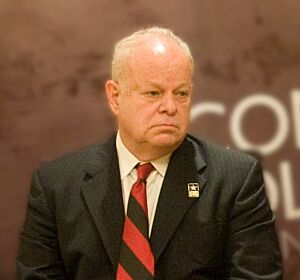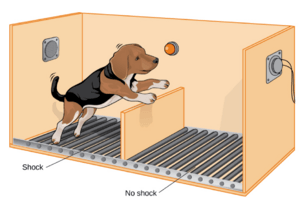Martin Seligman facts for kids
Quick facts for kids
Martin Seligman
|
|
|---|---|

Seligman in 2009
|
|
| Born | August 12, 1942 Albany, New York, U.S.
|
| Alma mater | |
| Known for |
|
| Awards |
|
| Scientific career | |
| Fields | Psychology |
| Institutions | University of Pennsylvania |
| Signature | |
Martin Elias Peter Seligman (born August 12, 1942) is a famous American psychologist. A psychologist studies how people think, feel, and behave. He is also an educator and has written many helpful books.
Seligman is well-known for his ideas about well-being and positive psychology. Positive psychology focuses on what makes people happy and strong, rather than just what makes them sad or sick. He also developed a theory called learned helplessness, which is very important in understanding how people react to difficult situations. Many scientists and therapists use his ideas. In 2002, a study showed he was one of the most often mentioned psychologists of the 20th century.
Today, Dr. Seligman is a professor of psychology at the University of Pennsylvania. He leads the university's Positive Psychology Center. He was also the president of the American Psychological Association in 1998. He has written books like The Optimistic Child and Flourish, which help people understand how to live happier lives. His most recent book, Tomorrowmind, was published in 2023.
Contents
Early Life and Education
Martin Seligman was born in Albany, New York. He went to public school and then to The Albany Academy. He studied philosophy at Princeton University, finishing in 1964 with top honors. He then earned his PhD in psychology from the University of Pennsylvania in 1967. In 1989, he received an honorary degree from Uppsala University in Sweden.
Understanding Learned Helplessness
Dr. Seligman's important work on "learned helplessness" started in 1967 at the University of Pennsylvania. He was studying depression, a feeling of deep sadness. He and his team were doing experiments with dogs. They noticed something unexpected. After the dogs experienced situations where they couldn't escape mild electric shocks, they later didn't try to escape, even when they could. It was like they had "learned" to be helpless.
Seligman realized this could explain some human behaviors. He found that learned helplessness is a state where a person or animal learns to act helpless in a situation. This often happens after they've been unable to avoid a bad situation. Even if they later gain the power to change things, they might not try. Seligman thought this was similar to how people with severe depression feel. He believed that depression can partly come from feeling like you have no control over what happens. Later, he and another psychologist, Lyn Abramson, added to this idea. They said that how people explain bad events to themselves also plays a role.
What Makes People Happy?
In his 2002 book, Authentic Happiness, Dr. Seligman explained his ideas about happiness. He believed that happiness is made up of three main things:
- Positive emotion: Feeling joy, pleasure, and other good feelings.
- Engagement: Being completely absorbed in an activity, like when you're so focused on a game or hobby that you lose track of time.
- Meaning: Feeling like your life has purpose and you're part of something bigger than yourself.
Exploring Positive Psychology
Dr. Seligman worked with another psychologist, Christopher Peterson, to create a different kind of guide for understanding people. Usually, books like the Diagnostic and Statistical Manual of Mental Disorders (DSM) focus on mental health problems. But Seligman and Peterson wanted to look at what goes right with people.
Their book, Character Strengths and Virtues (published in 2004), explores good qualities. They studied different cultures and times in history to find virtues that people have always valued. They found six main character strengths:
- Wisdom/Knowledge: Being smart and curious.
- Courage: Being brave and persistent.
- Humanity: Being kind and loving to others.
- Justice: Being fair and a good leader.
- Temperance: Having self-control and being humble.
- Transcendence: Appreciating beauty, having hope, and feeling connected to something larger.
Each of these strengths has smaller parts. For example, temperance includes forgiveness and self-control. Seligman and Peterson believe that none of these virtues are more important than the others.
Understanding Well-Being
In his 2011 book, Flourish, Dr. Seligman talked about his "Well-Being Theory." He explained that for something to be a part of well-being, it needs three things:
- It helps you feel good.
- People want it for its own sake, not just to get something else.
- It can be measured on its own.
Seligman concluded that there are five important parts of well-being, which he calls PERMA:
- Positive Emotion: How you feel inside, like joy or happiness.
- Engagement: Being totally focused and absorbed in an activity, like when you're in a "flow state."
- Relationships: Having good connections with friends, family, and others.
- Meaning: Feeling like your life has a purpose and you're serving something important.
- Achievement: Reaching goals and feeling accomplished, even if it's hard work.
In July 2011, Dr. Seligman encouraged the British Prime Minister, David Cameron, to think about well-being when measuring how well a country is doing, not just money.
MAPP Program
The Master of Applied Positive Psychology (MAPP) program at the University of Pennsylvania was started by Dr. Seligman in 2003. It was the first program of its kind to teach people about positive psychology.
Personal Life
Dr. Seligman enjoys playing bridge, a card game. He finished second in a major North American bridge championship in 1998. He has won many regional championships too.
He has seven children and four grandchildren. He and his second wife, Mandy, live in a house that used to belong to a famous conductor, Eugene Ormandy. They have taught five of their children at home. Dr. Seligman was also inspired by the work of psychiatrist Aaron T. Beck, which helped him improve his own ideas and exercises.
See also
 In Spanish: Martin Seligman para niños
In Spanish: Martin Seligman para niños


